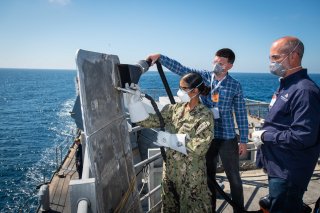America’s Navy Remains Crippled by Service and Repair Delays
Policymakers must do more to scrape the barnacles off Washington’s creaky bureaucracy.
The U.S. Navy performed without parallel in World War II, and more than met the challenges of the first Cold War. But both conflicts are firmly in the past. Today, we now face a formidable maritime and industrial power rival in China. The technological and geopolitical challenges we now face demand that the United States act much more urgently and faster. Nowhere is this more clear than in our Navy.
America desperately needs more ships, but maintenance delays result in, as one retired admiral put it, “the equivalent of losing half an aircraft carrier and three submarines each year.”
The USS Connecticut, a premier submarine, commissioned for service in 1998, struck an underwater mountain in the South China Sea in 2021. It won’t be back in service until 2026, according to the Navy. This is about three times as long as the sixteen months it took to build the Pentagon, the physical building, in the first place. By coincidence, the estimated cost of repair for the USS Connecticut is $80 million—equal to the cost of building the Pentagon ($1.1 billion in today’s dollars).
The Pentagon is a big place. Room for 25,000 workers. Parking spots for 9,700.
Defense officials and experts at the Hay Seward Initiative consider the US submarine force a crucial advantage over a numerically larger Chinese navy. But the U.S. Government Accountability Office (GAO) said in a 2022 summary concerning U.S. capabilities against China that the Navy lost 10,363 operational days from 2008 through 2018—the equivalent of more than twenty-eight years—“as a result of delays in getting into and out of the shipyards.”
Currently, an alarming eighteen of the Navy’s forty-nine fast-attack subs are out of service, awaiting repair and servicing. Fast-attack subs fire torpedoes and Tomahawk cruise missiles, which are essential to winning a potential fight against China over Taiwan or South China Sea lanes.
Maurer of the GAO explains that the Navy may be giving top priority “for scarce shipyard space” to aircraft carriers and ballistic-missile submarines, “which means attack subs are more likely to rack up idle time waiting to get into an available dry dock.”
This is totally unacceptable. The Connecticut is one of the United States’ three nuclear-powered Seawolf-class vessels, the service’s largest attack subs. The Navy describes the class as “exceptionally quiet, fast, well-armed, and equipped with advanced sensors.” It has eight torpedo tubes and can hold as many as fifty weapons in its torpedo room.
Ronald O’Rourke, a naval analyst with the Congressional Research Service, indicated that the delay is “a product of the complexity of modern warships – and thus the complexity of the work needed to repair damage to them.”
As I highlighted in Power Rivals: America and China’s Superpower Struggle, both the Navy and Congress need to address this issue without delay. The Pentagon, likewise, needs to be much more agile and nimble. Speed, flexibility, and time are just as important as the number of ships and subs. Advanced technology and complexity are great, but not if it leads to key assets sitting in dry dock.
Calls for bureaucratic reform are not new, and experts have long warned of the dangers of a culture that cripples organizations, as officials check boxes rather than get results.
The time for renewal, reform, and rebuilding is past due. It is high time to push for change in a bureaucratic Washington that is too much talk and little action.
Luckily, Washington has allies in South Korea and Japan that are building some of the highest quality and affordable naval assets in the world.
Buying ships from these countries, or building U.S.-designed vessels in their shipyards, perhaps including the Philippines in the mix as well, could be a cost-effective way of catching up with China.
All three countries have mutual defense treaties with the United States. So why doesn’t Washington team up with them to outbuild China?
The problem is largely political; U.S. law currently prevents the Navy from buying foreign-built ships, even from allies, or from building its own ships in foreign countries due to both security issues and to protect America’s shipbuilding industry.
Meanwhile, the Pentagon estimates China’s navy to have around 340 warships, while the United States has fewer than 300. It likewise estimates the Chinese fleet will grow to 400 in the next two years, while the U.S. fleet will take until 2045 to hit 350.
Voters should have a clear message for Washington: if more money is going to be spent on defense, then make sure it is being spent effectively.
Carl Timothy Delfeld is the co-founder of the Independent Republican and Hay Seward Initiative, managing director of Blackthread LLC, a former U.S. Treasury advisor, former U.S. Director of the Asian Development Bank, and author of Power Rivals: America and China’s Superpower Struggle.
Image: U.S. Navy/Flickr.

